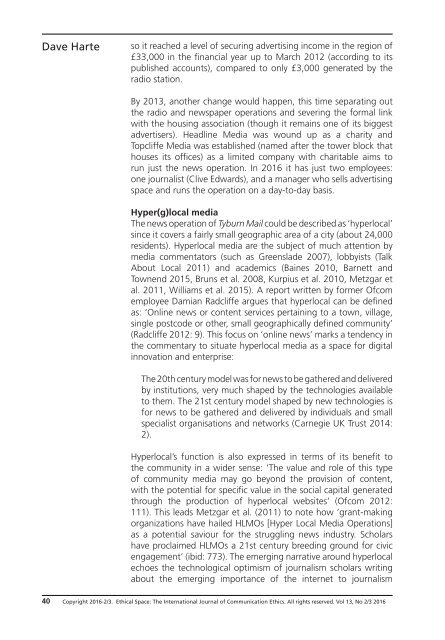Beyond clickbait and commerce
v13n2-3
v13n2-3
Create successful ePaper yourself
Turn your PDF publications into a flip-book with our unique Google optimized e-Paper software.
Dave Harte<br />
so it reached a level of securing advertising income in the region of<br />
£33,000 in the financial year up to March 2012 (according to its<br />
published accounts), compared to only £3,000 generated by the<br />
radio station.<br />
By 2013, another change would happen, this time separating out<br />
the radio <strong>and</strong> newspaper operations <strong>and</strong> severing the formal link<br />
with the housing association (though it remains one of its biggest<br />
advertisers). Headline Media was wound up as a charity <strong>and</strong><br />
Topcliffe Media was established (named after the tower block that<br />
houses its offices) as a limited company with charitable aims to<br />
run just the news operation. In 2016 it has just two employees:<br />
one journalist (Clive Edwards), <strong>and</strong> a manager who sells advertising<br />
space <strong>and</strong> runs the operation on a day-to-day basis.<br />
Hyper(g)local media<br />
The news operation of Tyburn Mail could be described as ‘hyperlocal’<br />
since it covers a fairly small geographic area of a city (about 24,000<br />
residents). Hyperlocal media are the subject of much attention by<br />
media commentators (such as Greenslade 2007), lobbyists (Talk<br />
About Local 2011) <strong>and</strong> academics (Baines 2010, Barnett <strong>and</strong><br />
Townend 2015, Bruns et al. 2008, Kurpius et al. 2010, Metzgar et<br />
al. 2011, Williams et al. 2015). A report written by former Ofcom<br />
employee Damian Radcliffe argues that hyperlocal can be defined<br />
as: ‘Online news or content services pertaining to a town, village,<br />
single postcode or other, small geographically defined community’<br />
(Radcliffe 2012: 9). This focus on ‘online news’ marks a tendency in<br />
the commentary to situate hyperlocal media as a space for digital<br />
innovation <strong>and</strong> enterprise:<br />
The 20th century model was for news to be gathered <strong>and</strong> delivered<br />
by institutions, very much shaped by the technologies available<br />
to them. The 21st century model shaped by new technologies is<br />
for news to be gathered <strong>and</strong> delivered by individuals <strong>and</strong> small<br />
specialist organisations <strong>and</strong> networks (Carnegie UK Trust 2014:<br />
2).<br />
Hyperlocal’s function is also expressed in terms of its benefit to<br />
the community in a wider sense: ‘The value <strong>and</strong> role of this type<br />
of community media may go beyond the provision of content,<br />
with the potential for specific value in the social capital generated<br />
through the production of hyperlocal websites’ (Ofcom 2012:<br />
111). This leads Metzgar et al. (2011) to note how ‘grant-making<br />
organizations have hailed HLMOs [Hyper Local Media Operations]<br />
as a potential saviour for the struggling news industry. Scholars<br />
have proclaimed HLMOs a 21st century breeding ground for civic<br />
engagement’ (ibid: 773). The emerging narrative around hyperlocal<br />
echoes the technological optimism of journalism scholars writing<br />
about the emerging importance of the internet to journalism<br />
40 Copyright 2016-2/3. Ethical Space: The International Journal of Communication Ethics. All rights reserved. Vol 13, No 2/3 2016


